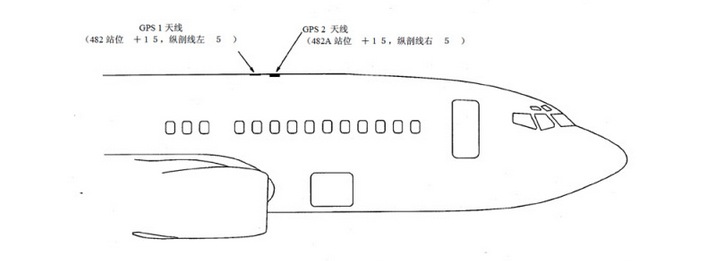Both military and civilian aircraft have several sets of communication equipment. Some are connected to satellites and some are connected to the ground. Regardless of the connection, all need antennas. Even a small quadcopter drone, but also through the GPS antenna to locate.
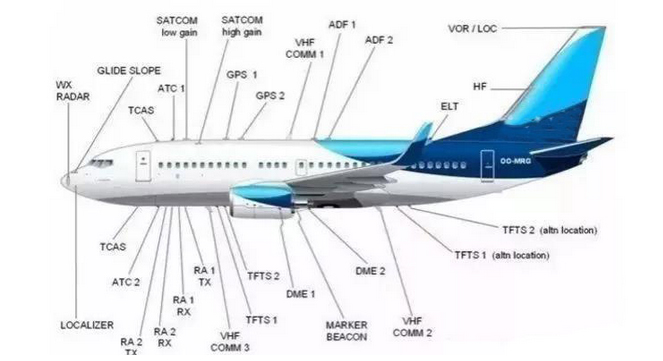
Boeing 737 Antenna Layout
Similarly, smart cars have more and more array antennas such as various cellular bands, Wi-Fi, even 5G and its MIMO requirements, V2V (Vehicle to Vehicle), Radar (77GHz etc.) and so on. Its own mobility adds to the design difficulty. In terms of RF requirements and constraints, the antenna design and layout of autonomous vehicles will become more like aircraft design.

Array Antennas in Smart Cars
High Frequency (HF)
High Frequency (HF) communication systems provide long range voice communication. It provides communication between aircraft and aircraft or between ground stations and aircraft.
The HF system operates between 2MHz and 29.999MHz frequencies. The system utilizes the Earth's surface and the ionosphere to propagate communication signals by reflecting them back and forth. The distance of reflection varies with time, radio frequency, and altitude of the aircraft.
The control panel sends the selected frequency information and control signals to the transceiver. The audio control board sends these signals to the REU:
- HF radio selector signal
- Receive volume control
- Push-to-talk (PTT)
During transmission, the microphone tone and PTT signal enter the HF transceiver via the REU. The transceiver uses the handset tone to modulate the RF carrier signal generated by the transceiver. The transceiver sends the modulated RF signal through the antenna coupler to the antenna for transmission to other aircraft or ground stations.
The DFDAU receives the PTT signal from the transceiver also during transmission, and the DFDAU uses the PTT as a keying signal to record the transmission event.
During reception, the antenna receives the modulated RF signal and sends it through the antenna coupler to the transceiver. The transceiver demodulates or separates the audio from the RF carrier. The received audio is sent from the HF transceiver to the in-flight intercom speaker and headset via the REU.
The Selective Call Decoder receives audio from the HF transceiver.The SELCAL decoder monitors SELCAL call audio from the ground station.
The HF transceiver receives a discrete air/ground signal, which is used by the HF transceiver to calculate the flight segment for the internal fault memory.
The HF antenna is at the leading edge of the vertical stabilizer.
The antenna coupler is inside the vertical stabilizer.
WARNING: When the HF system is transmitting, make sure the crew is at least six feet (2 meters) from the vertical stabilizer. RF energy emitted from the HF antenna is harmful to humans.
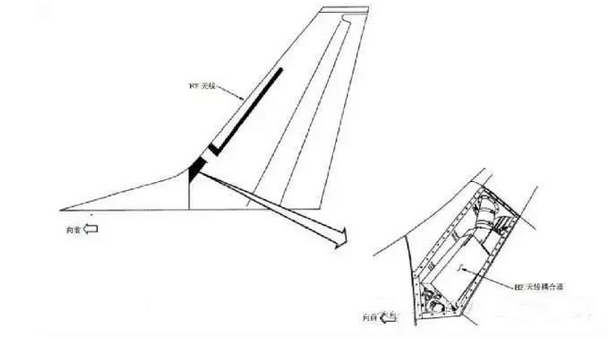
VHF Communication System
VHF Communication System
The VHF communication system provides voice and data line-of-sight communications for aircraft crews and can be used for aircraft-to-aircraft and aircraft-to-ground station communications.
The VHF radio tuning frequency range is from 118.00 to 136.975 MHz and the VHF radio is used by transmitters to receive voice communications.
The VHF communication system operates in the frequency range of 118.00 MHz to 136.975 MHz, and the 8.33 KHz interval applies only in these frequency bands:
- 118.000-121.400
- 121.600-123.050
- 123.150-136.475
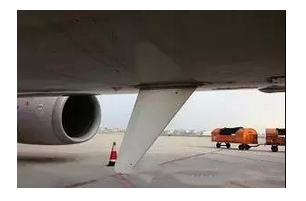
Instrument Landing System (ILS)
Heading Antenna
The Heading Channel Antenna has two elements. One element provides RF input to the ILS receiver 1 and the other element provides RF input to the ILS receiver 2. The fairway antenna receives frequencies from 108.1 MHz to 111.95 MHz, separated by an odd number of tenths of the bandwidth.
Down Channel Antenna
The down-channel antenna also has two elements. One element provides RF signal input to MMR 1 and the other element provides RF signal input to MMR 2. The down-channel antenna receives frequencies from 328.6 MHz to 335.4 MHz.
The downtrack and heading antenna are inside the front radar antenna enclosure. The downtrack antenna is above the weather radar antenna. The fairway antenna is below the weather radar antenna.
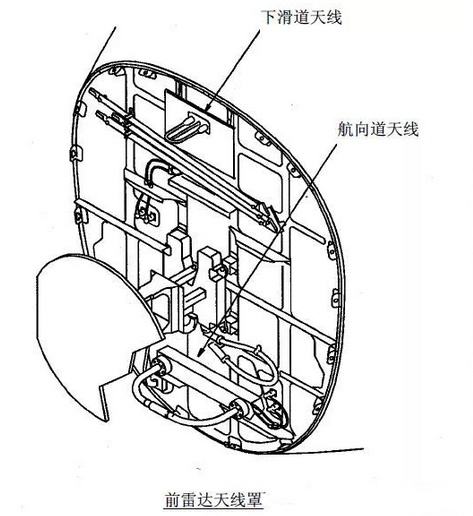
Pointing Beacon System
The Pointing Beacon System provides audio and video instructions to aircraft as they fly over runway pointing beacon transmitters.

The pointing beacon antenna is located at the bottom of the aircraft fuselage
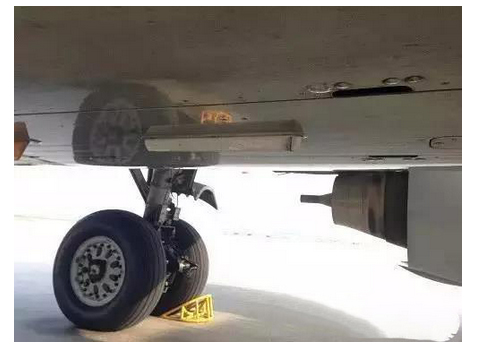
Radio Altimeter System
The Radio Altimeter (RA) system measures the vertical distance from the aircraft to the ground.The radio altitude is displayed on a display unit (DU) in the cockpit. The radio altitude is calculated by comparing the transmitted signal with the received signal using a receiver transmitter element that transmits a radio signal and then receives a reflected RF signal back from the ground to determine the aircraft's altitude. the R/T outputs the calculated altitude data to two ARINC 429 data buses and sends it to the aircraft's utilizing systems.
The altitude data is used by the flight crew and other aircraft systems during low altitude flight, approach and landing. The range of the system is -20 to 2500 feet.
Adjustable radio minimum altitude warnings are operated by the radio altitude system and can be independently selected from 0 - 999 feet by the captain and co-pilot EFIS consoles. This radio minimum altitude option compares and processes existing radio altitude values from the radio altitude receiver/transmitter outputs in the Display Electronic Unit (DEU). When the aircraft descends to the selected radio minimum altitude, a blinking radio minimum warning appears on the available DEUs.
The RA antenna is on the bottom of the airframe.
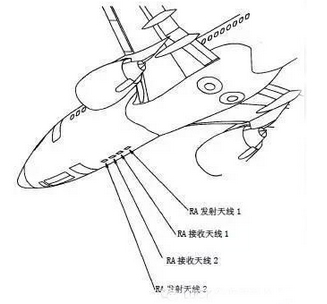
Traffic Alert and Collision Avoidance System
The Traffic Alert and Collision Avoidance System (TCAS) helps crews maintain safe air traffic separation from other ATC-equipped aircraft, and is an on-board system that operates independently of the ATC system on the ground.
TCAS sends an interrogation signal to neighboring aircraft.Those aircraft equipped with ATCRBS (Air Traffic Control Radar Beacon System) transponders or one of the ATC S-mode transponders respond to the interrogation, and TCAS uses the response signals to calculate the distance to them, the relative bearing, and the altitude of the responding aircraft. If the responding aircraft does not report an altitude, TCAS cannot calculate the altitude of that aircraft. Aircraft that are tracked by TCAS are called targets.
Using the information in the response signal and the altitude of its own aircraft, TCAS calculates the relative motion between the target and its own aircraft, and then calculates how close the target will be to its own aircraft at its closest approach point (CPA).
The target is categorized into one of the following four categories, depending on the interval at the CPA point and the time at which the CPA point will occur:
- Other Traffic
- Approaching Traffic
- Intruder
- Intruder.
The targets are symbolized differently on the display.
TCAS provides advisories to the unit if the CPA interval is within a certain limit. TCAS provides two levels of advisories to the unit, Traffic Advisory (TA) and Relief Advisory (RA), depending on the altitude and the time of occurrence of the CPA and the size of the interval at the CPA. Traffic Advisory (TA) is until the CPA occurs relatively farther away and the interval between the CPA point and the intrusion target is relatively large. Relief Advisory (RA) is the time until the CPA occurs is relatively short and the separation between the CPA point and the threat target is relatively small.
Traffic Advisory (TA) indicates the distance, bearing, and relative altitude of the incursion target (if its altitude is known). The RA also provides visual and verbal instructions to the crew that there is a safe vertical separation from the threat target.
The TCAS also communicates with the other TCAS-mounted aircraft to coordinate its flight operations to prevent a collision.
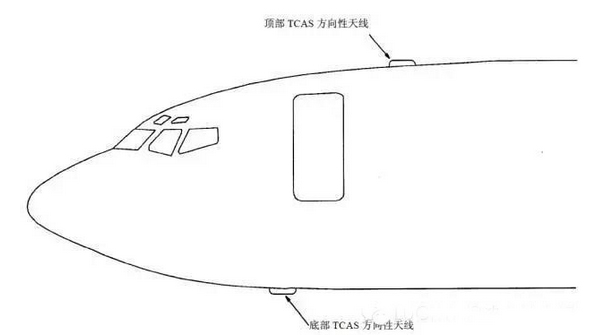
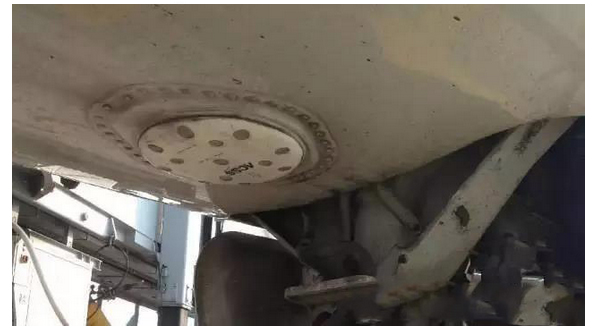
VOR System
The VOR system has two very high frequency omnidirectional beacon/pointing beacon (VOR/MB) receivers. The receivers have VOR and pointing functions. This section covers only the VOR operation of the VOR/MB receivers.
The navigation (NAV) console provides manual tuning input to the VOR/MB receiver. There are two NAV consoles, one used by the pilot and the other by the co-pilot. RF signals from the VOR/LOC antenna pass through a power splitter and arrive at the VOR/MB receiver, which uses the RF signals to calculate the direction of the earth station and decode the Morse code station identification word and station audio signals.
The receiver sends VOR bearings to the remote magnetic indicator (RMI). The RMI bearing indicator can be selected using the RMI Bearing Pointer Selector to display either VOR or ADF ground station bearings.
The receiver sends VOR bearing information to the Display Electronics Unit (DEU) for display purposes.The NAV selector gate allows the unit to select either VOR/MB Receiver 1 or VOR/MB Receiver 2 as the source of the Captain's and Co-Pilot's display information.The NAV selector gate allows the unit to select VOR/MB Receiver 1 or VOR/MB Receiver 2 as the source of the Captain's and Co-Pilot's display information.
The receiver sends station audio and Morse code station identifier signals to the remote control electronics unit (REU).
The receiver sends VOR bearing data to the FCC for DFCS VOR/LOC mode operation. The bearing data is also sent to the FMCS as a radio navigation aid for current position calculation.
The VOR/LOC antenna is at the top of the vertical stabilizer.
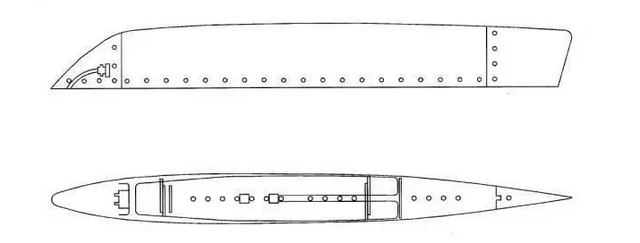
Air Traffic Control System
Air Traffic Control (ATC) ground stations interrogate the onboard ATC system, and the ATC answering machine responds to the ground stations by answering their interrogations with coded information in the required format.
The ATC transponder also responds to Mode S inquiries from other aircraft or ground stations with Traffic Collision Avoidance Systems (TCAS).
When a TCAS computer at a ground station or on another aircraft interrogates the ATC system, the transponder transmits a pulse-coded response signal that identifies and indicates the aircraft and its altitude.
The ATC antenna is mounted at the front of the fuselage near the centerline. The top antenna is located at station 430.25. The bottom antenna is located at station 355.
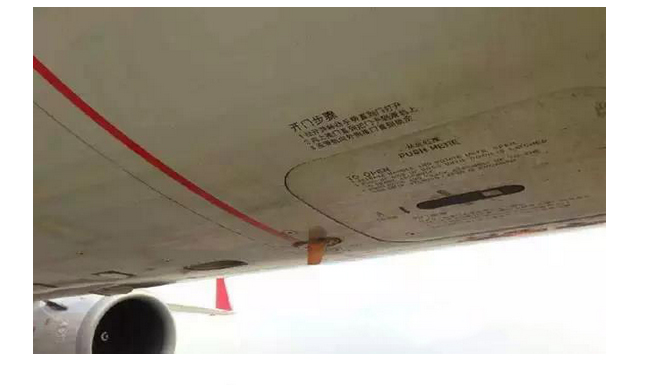
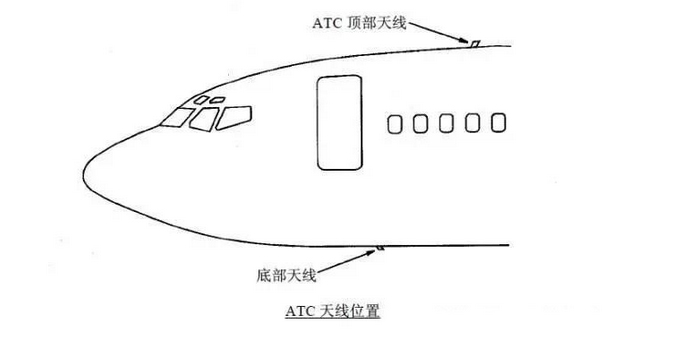
Distance Measuring Equipment (DME)
The Distance Measuring Equipment (DME) system provides measurements of the slant (line-of-sight) distance between an aircraft and a ground station.
The DME system has two interrogators and two antennas.
The interrogators receive manual tuning inputs and automatic tuning inputs from the Flight Management Computer System (FMCS) at the navigation console. If the navigation console tuning input fails, the interrogator receives auto-tuning input directly from the FMC.
The DME system sends data to the display electronics for display on the primary flight display (PFD) and the navigation display (ND).
The DME system sends data to the following components:
- Flight Control Computer (FCC)
- Flight Management Computer System (FMCS)
- Flight Data Acquisition Unit (FDAU)
- Remote control electronic unit (REU)
The FCC uses the DME data as an input to calculate the VOR capture points in the autopilot in VOR mode.The DME data is also used in VOR mode to find out when overflight of a particular VOR ground station is sensed.
The FMCS uses DME to calculate the FMC position update.
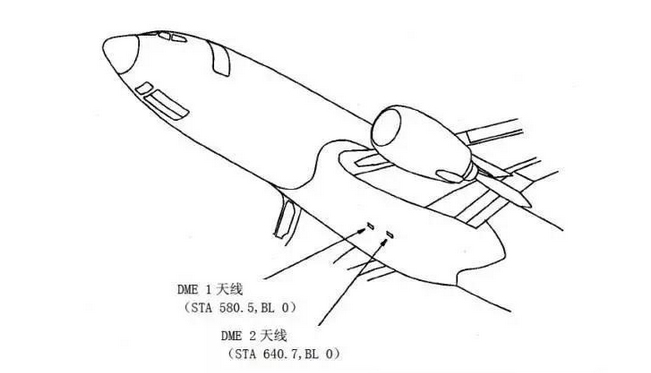
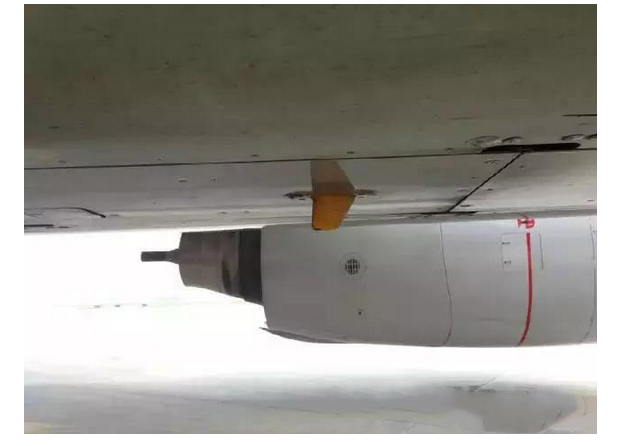
Automatic Directional Flying System
The Automatic Directional Flying (ADF) system is a navigational aid that uses an AM signal from a ground station to calculate the orientation of the ADF ground station relative to the longitudinal axis of the aircraft.The ADF system also receives standard AM radio broadcasts.
The ADF antenna is located on the upper fuselage of fuselage station element 694. (The ADF antenna is located on the fuselage of fuselage station element 694.)
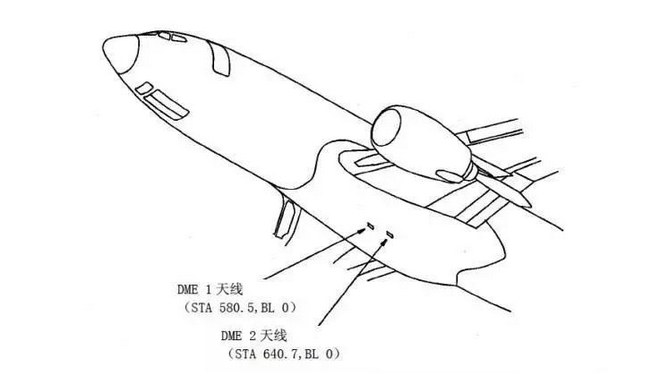
GPS
The Global Positioning System (GPS) calculates data for:
- Latitude
- Longitude
- Altitude
- Precise time
- Ground Speed
There are two GPS systems on board the aircraft, antenna 1 receives the satellite signals and sends them to Multi-Mode Receiver 1 (MMR 1), and antenna 2 connects to MMR 2. The MMR calculates the position and precise time of the aircraft and sends this information to the Flight Management Computer System (FMCS) and the IRS Master Reminder Element (IRS).
The MMR calculates the aircraft position and precise time and sends this information to the Flight Management Computer System (FMCS) and the IRS Master Alert Element (MAE), which utilizes position data from the GPX or navigational radios along with inertial datum data to calculate the aircraft position.
The ADIRU position data is sent to the MMRs, and the IRS Master Alert Element receives GPS data from both MMRs. When both GPS receivers are faulty the GPS fault lamp on the IRS mode selector illuminates, or the GPS fault lamp illuminates when one GPS receiver is faulty and the master alert sign is depressed.
The Geo-Proximity Warning Computer (GPWC) obtains GPS position and velocity data from the Multi-Mode Receiver (MMR).
The clock gets GPS time data from the MMR.
The GPS antenna is mounted on the top of the unit.
